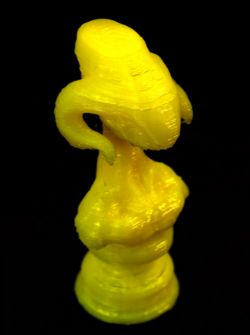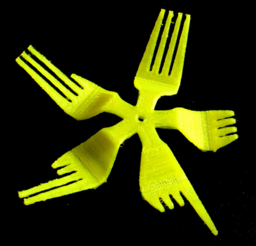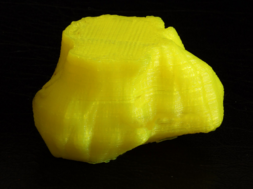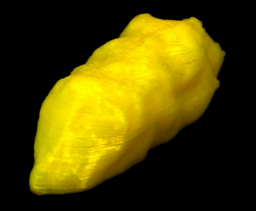Do you keep track of how long it takes you to get through a single roll of filament? What about the number of objects you can print with it? If you’re a prolific maker, those rolls of filament may eventually just start to run together. Whoops, this one’s done, pop in another and carry on. Seriously, is it time to buy new filament already? Sigh.
Art curator Gabriel Menotti is curious about how just how much you can print with a single 800cm³ spool of PLA filament, so he put together a project to find out, and to display the results. The appropriately named APPROXIMATELY 800cm³ OF PLA is an exhibition currently running as part of the online art event The Wrong (again) – New Digital Art Biennale. The project began with an open call for submissions of 3D design files from anyone who wanted to participate. Every day, one item is selected from the emailed entries, printed, and displayed on the project website. All selected entries have so far been printed from a single 800cm³ spool of PLA, and the project will continue until the spool has run out.
It’s a fun concept that almost seems a bit gimmicky until you consider the deeper motivation behind it. As an event press release states:
“Much of the excitement about digital fabrication technologies comes from the limitless reproducibility they seem (to) allow. 3D printed materials in particular have acquired the status of a new primordial clay, able to take any imaginable shape, recuperating historical artefacts that have been ruined and restoring the capacity of walking to the invalid. But, as with other theologies of prosperity, this one can be very contradictory. The presentation of 3D printing as a technology of abundance overlooks not only the secular obstacles of copyright legislation, but also the world’s material scarcity, as if the transformation of prime matter into manufactured goods consumed no energy or natural resources.”
APPROXIMATELY 800cm³ OF PLA takes the limitless resources that 3D printing offers and makes them finite, making you ask yourself what you would print if you only had a limited amount of material to work with. As the project’s coordinators ask, “Will it be enough for everything that is worth being made?” Of course it won’t, and that’s the message behind the exhibition. It’s incredible to be able to create and create, seemingly infinitely, but when it becomes that easy, we run the risk of taking those resources for granted.
The project is sort of a microcosm of the 3D printing world, displaying everything from the profound to the profane. Some, like Patrick Lichty’s print of his friend’s brain tumor MRI, illustrate the incredible potential of 3D printing and crowdsourcing to save lives – Lichty’s notes state that his afflicted friend, Salvatore Iaconesi, uploaded all of his medical data to the Internet as an open source project intended to find a cure. Then there’s the “just because we can” aspect of 3D printing, like the entry from Dennis de Bel, who actually scanned and printed his own excrement. I guess that’s how we know 3D printing has really made it as an art form, because where would high art be without the scatological?
If you’d like to submit your own entry, you can email the STL or OBJ file to 800cm3@gmail.com. Full conditions can be found here, but entrants are encouraged to submit absolutely anything they can think of, “even things that were not originally intended to be printed!” The printed entries will be on display at Baile in Vitoria, Brazil, as well as on the project website. Discuss this story in the 3D Printing With PLA forum on 3DPB.com.
Subscribe to Our Email Newsletter
Stay up-to-date on all the latest news from the 3D printing industry and receive information and offers from third party vendors.
Print Services
Upload your 3D Models and get them printed quickly and efficiently.
You May Also Like
HP and Firestorm Labs Form Partnership to Use Multi Jet Fusion 3D Printers in Deployable Factories
HP Inc., maker of a range of additive manufacturing (AM) solutions including the Multi Jet Fusion (MJF) ecosystem, has announced a partnership with Firestorm Labs, a developer of containerized, deployable...
3D Printing News Briefs, July 2, 2025: Copper Alloys, Defense Manufacturing, & More
We’re starting off with metals in today’s 3D Printing News Briefs, as Farsoon has unveiled a large-scale AM solution for copper alloys, and Meltio used its wire-laser metal solution to...
Reinventing Reindustrialization: Why NAVWAR Project Manager Spencer Koroly Invented a Made-in-America 3D Printer
It has become virtually impossible to regularly follow additive manufacturing (AM) industry news and not stumble across the term “defense industrial base” (DIB), a concept encompassing all the many diverse...
U.S. Navy Lab Uses 3D Printing to Reduce Tooling Lead Time By Over 90%
The F-35 Lightning II Joint Program Office (JPO), responsible for life-cycle management of the key fifth-generation joint strike fighter (JSF) system used by the U.S., its allies, and its partners,...





































